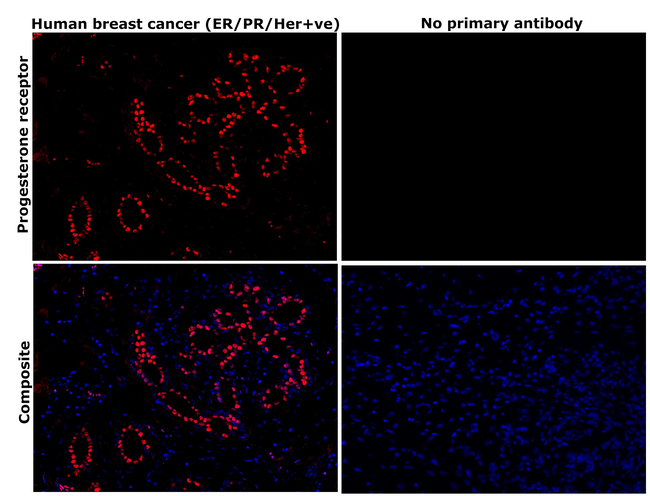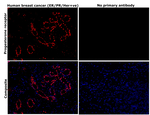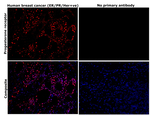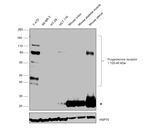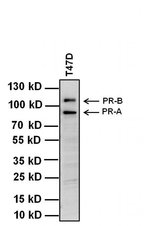Search Thermo Fisher Scientific
RWD
Progesterone Receptor Monoclonal Antibody (PR-AT 4.14)
Mouse Monoclonal Antibody
| Catalog Number | Quantity |
|---|---|
| RWDM-A14-10 | 100 μg |
Catalog number RWDM-A14-10
Price (MYR)
1,400.00
Special offer
Ends: 31-Dec-2025
1,400.00Each
Quantity:
100 μg
Price (MYR)
1,400.00
Special offer
Ends: 31-Dec-2025
1,400.00Each
MA1-410 detects the progesterone receptor (PR) from human, non-human primate, bovine, rat, rabbit, and mouse tissues. This antibody does not cross-react with androgen receptor, estrogen receptor or glucocorticoid receptor. MA1-410 has been successfully used in Western blot, immunohistochemical and immunoprecipitation procedures. By Western blot, this antibody detects a 94 kDa and a 120 kDa protein representing PRA and PRB, respectively from T47D whole cell lysate. MA1-410 performs better by western blot using BSA as the blocking agent and in antibody diluent. The MA1-410 immunogen is a synthetic peptide corresponding to the binding domain residues G(533) L P Q V Y P P Y L N Y L R P(547) of human Progesterone Receptor. MA1-410 can be used with blocking peptide PEP-016.
The progesterone receptor (PR) is a member of the steroid family of nuclear receptors. The PR mediates the physiological effects of progesterone, which plays a central role in reproductive events associated with the establishment and maintenance of pregnancy. PR is found as a 94 kDa protein (Form A) or a 120 kDa protein (Form B) due to the use of alternative translation initiation sites. PR-B is the transcriptionally active form and is responsible for activating genes for the maintenance of the endometrium, maintenance of pregnancy, and inhibition of ovulation. PR-A is identical to PR-B except for a 165 amino acid deletion at the N-terminus. This deletion exposes a 140 amino acid inhibitory domain (ID) that acts as a repressor of steroid hormone transcriptional activity. In its inactive state, PgR forms a multiprotein complex which includes heat shock proteins and immunophins. Upon binding of progesterone hormone to its receptor, there is a conformational change that allows dimerization and binding of the receptor to progesterone response elements (PRE) sequences, resulting in activated transcription. A Null mutation in the PGR gene leads to pleiotrophic reproductive abnormalities.
Specifications
AntigenProgesterone Receptor
ApplicationsChIP Assay, Immunohistochemistry (Frozen), Immunohistochemistry (Paraffin), Immunoprecipitation, Western Blot
ClassificationMonoclonal
ClonePR-AT 4.14
Concentration1 mg/mL
ConjugateUnconjugated
FormulationPBS with 1 mg/mL BSA and 0.05% sodium azide
GenePGR
Gene Accession No.P06186, P06401, Q00175, Q63449
Gene Alias9930019P03Rik; BB114106; ENSMUSG00000074510; LOW QUALITY PROTEIN: progesterone receptor; NR3C3; Nuclear receptor subfamily 3 group C member 3; p4 receptor; PGR; pot. alt. progesterone receptor; putative; PR; PR-A; PR-B; Progesterone receptor; progesterone receptor A; progesterone-receptor; putative form B; steroid hormone receptor; testicular progesterone receptor; unnamed protein product
Gene SymbolsPGR
Host SpeciesMouse
ImmunogenSynthetic peptide corresponding to residues G(533) L P Q V Y P P Y L N Y L R P(547) of human Progesterone Receptor.
Purification MethodProtein A
Quantity100 μg
Regulatory StatusRUO
Primary or SecondaryPrimary
Gene ID (Entrez)100009094, 100848466, 18667, 25154, 5241
Target SpeciesHuman, Mouse, Rat, Rabbit, Monkey, Bovine
Product TypeAntibody
FormLiquid
IsotypeIgG1
Unit SizeEach
Contents & Storage
-20°C, Avoid Freeze/Thaw Cycles

